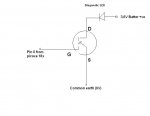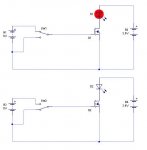Hello, a little help is needed.
I am THAT close to completing my picaxe solar tracker. Thank you to forum members who have helped me solve my EEPROM programming problems, my i2c interfacing and my potentiometer problems.
So, I got everying working nicely, with indicator LEDs sitting on the ouputs of the picaxe 18x where I planned to put the H Bridges that will control the rather power hungry tracking motors. All work well, things light up when they should and I can pretend to be the tracking motor, moving the potentiometers to simulate the panels moving and the circuit then turns the indicator LEDs of when expected. I THOUGHT I could do the HBridge bit myself, but I am stumped.
I don't have the tools to produce a ledgeable circuit diagram, but it is simple enough to describe.
I have connected Output 0 of the picaxe 18x to the G connection of a MTP3055VL mosfet, (just the first one of the four that will make the H Bridge for testing purposes only at this stage). I have connected the S pin of the mosfet to 0V ( the common ground rail for everything, including the picaxe chip) and I have a separate test battery (3.6V) and diode connected to D and the common ground simulating the tracking motor.
So now the odd bit. When I set pin 0 high, my test LED goes OFF, when I set it low, the test LED goes ON. This is exactly the reverse of what I expected! Even stranger still, if I turn the picaxe supply power off, the test LED goes off too, which is doubly odd as I would have thought that was the electrical equivalent of setting pin 0 low, but I understand that such assumptions do not always hold with picaxes.
So my question is... is this what SHOULD happen? Is my understanding of mosfets completely back to front? I thought putting the G pin high "turns the mosfet on" in a manner of speaking, but quite the reverse is occuring.
Or do I have the wrong sort of mosfet?
Help please.
Matthew
I am THAT close to completing my picaxe solar tracker. Thank you to forum members who have helped me solve my EEPROM programming problems, my i2c interfacing and my potentiometer problems.
So, I got everying working nicely, with indicator LEDs sitting on the ouputs of the picaxe 18x where I planned to put the H Bridges that will control the rather power hungry tracking motors. All work well, things light up when they should and I can pretend to be the tracking motor, moving the potentiometers to simulate the panels moving and the circuit then turns the indicator LEDs of when expected. I THOUGHT I could do the HBridge bit myself, but I am stumped.
I don't have the tools to produce a ledgeable circuit diagram, but it is simple enough to describe.
I have connected Output 0 of the picaxe 18x to the G connection of a MTP3055VL mosfet, (just the first one of the four that will make the H Bridge for testing purposes only at this stage). I have connected the S pin of the mosfet to 0V ( the common ground rail for everything, including the picaxe chip) and I have a separate test battery (3.6V) and diode connected to D and the common ground simulating the tracking motor.
So now the odd bit. When I set pin 0 high, my test LED goes OFF, when I set it low, the test LED goes ON. This is exactly the reverse of what I expected! Even stranger still, if I turn the picaxe supply power off, the test LED goes off too, which is doubly odd as I would have thought that was the electrical equivalent of setting pin 0 low, but I understand that such assumptions do not always hold with picaxes.
So my question is... is this what SHOULD happen? Is my understanding of mosfets completely back to front? I thought putting the G pin high "turns the mosfet on" in a manner of speaking, but quite the reverse is occuring.
Or do I have the wrong sort of mosfet?
Help please.
Matthew




